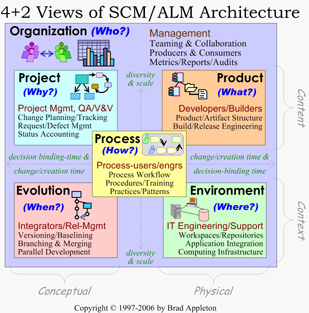The November issue of The Rational Edge has three articles that are closely related to my ideas about applying what we know about software & enterprise "architecture" to the domain of SCM/ALM solutions (and another article about an SCM tool vendor "eating their own dogfood"):
Some of you may recall my 4+2 Model Views of SCM Solution Architecture. I've since updated the picture a bit as follows (which Ive now updated over there too), click on the small image below to see a much larger one:

Anyway - reading through the above articles (particularly the one on model "dimensions" and the one on UML+RUP+Zachman together) gave me some more thoughts about my 4+2 views model, such as:
- I have "scale & diversity" as a dimension of "concerns" that bridge all views. I wonder if that corresponds to the "scale" or "level" dimension referred to the in article on dimensions of system models?
- I also have change/creation time, and decision binding time as a "dimension" of concerns. It's not explained real well though. I suppose it corresponds to considering both a "static" and "dynamic" perspective for each view. In a sense there are lifecycles (e.g., promotion cycles) for the elements in each view, as well as important times when decisions are committed to, and/or when artifacts or changes are made. When dealing with variation (diversity) across a product or system, the binding-time employed by the solution can be of great importance.
- By adding a +2 view to RUP/Kruchten's original 4+1, I end up with something that sort of maps to the 6 columns of the Zachman model. Does this mean my 4+2views are really a subset of Enterprise Architecture (EA), or might it mean that its some kind of "bridge" between the two?
- Does it really make sense for me to have Organization and data combined into a single view, or is Data really a separate view (a +3 view?), or should I not go so far as to equate metrics, queries and reports with "Data", but rather as the requirements for data (and hence the possible "bridge" mentioned above)?
- What if I compare contrast my 4+2 views with the model or views put forth by any of ITIL, RUP-SE, DODAF, TOGAF, FEAF, or others (see below)? What value does mine add that warrants being its own "thing" instead of just some poor sawed-off wannabe clone of one of the others?
Anyways, these questiosn made me want to go look-up some of these other models and views. I found some pretty good online articles for some of them (I'm sure I missed a few as well). Here they are:
I welcome feedback/comments on any of my thoughts above!


